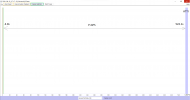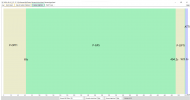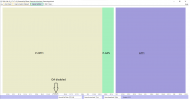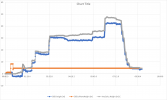mobilehomer
Well-Known Member
First - RTFM, many times, especially the italicized and bold sections. Then PRACTICE slow maneuvers. There are no DJI drones that use the Fly app that disable the VPS regardless of the OA condition.
Losing GPS does not cause a crash.I agree, but I do not believe that slipping out of P-GPS mode caused the crash, because I saw no unstable behavior nor ATTI mode at take off and during the first minute of the flight, which happened in the same environmentaL conditions and no GPS.
You might not believe it but without GPS or VPS, the drone is in Atti Mode.This is a very interesting observation that escaped me at first, i.e., that drifting towards the wall was being prevented by the OA system. However, as I said above, I do not believe that losing GPS brought the drone directly into ATTI mode
Your GPS reliability dropped below the necessary 4/5 from 8:11.0 and within a couple of seconds (8:14.3) the drone was in Atti Mode., both because of my visual recollection and because a summary look at the logs shows that GPS was lost after 8m26.5s of flight and ATTI mode was entered after 8m42s.
It's not disabled. It just can't work without VPS or GPS.Moreover I believe OA is disabled by default in ATTI.
VPS isn't disabled in Sport Mode.This article, for example (even though not directly from a DJI source), claims that in Sport mode, where OA is disabled by default, " if you're flying along in Sport mode and lose GPS for some reason, the drone will enter ATTI mode (as VPS was already disabled)".
Obstacle avoidance is not disabled by switching off VPS.However, I see absolutely no good reason for a software implementation in which OA is switched off by switching off the vision system.
What went wrong is quite clear.However, it keeps the question of what went wrong in my case still open. It possibly points at an independent failure of P-OPTI after OA was disabled.
The article is incorrect.The point I was making is that the article implies that disabling OA implies disabling VPS.
Your imaginary jury doesn't know the facts.In this case however, it seems the jury is still out on whether disabling OA when GPS is lost disables VPS.
Empirical, the drone being at eye level or only slightly higher and in a hover, so that I could see the movements.or do they correspond to empirical observations? And also do they represent a static error (i.e., the drone went to a stable position whose distance from the commanded is given by those numbers) or was the drone sort of oscillating around the commanded position with an amplitude of oscillations given by those numbers?
IMO, this is really what it comes down to.Aggressive joystick input + no brakes is a bad move when the drone is close to obstacles and that's what caused your crash.
Lol, someone got out of bed the wrong side, apparently. While I do appreciate your help, I'm not a big fan of the line by line bickering typical of online forums, so while I will try to reply to all the points you make (at least to the relevant ones), I will do so in the context of a more articulate discussion. In other words, I will be long and boring and not as catchy as your one-line zingers.Your imaginary jury doesn't know the facts.
Losing GPS does not cause a crash.
How you handle the drone without GPS could well cause a crash.
Atti Mode doesn't cause "instability".
The drone will maintain height and is perfectly controllable.
Sure, an icy road does not cause a crash, but how you handle the car on it that might result in one. I am a firm believer in the use of shortcuts in communication, when the implicit logic behind them is very obvious. I guess in this case it wasn't that obvious, but luckily you got what I meant about the loss of GPS.You might not believe it but without GPS or VPS, the drone is in Atti Mode.
Atti Mode is P-GPS without GPS.
I decided to start this thread because I experienced a crash that opened my eyes to how unexpectedly a transition to open-loop mode can happen and as a consequence I was looking to gain more insight on the conditions that trigger it either from people who have been in a similar situation or from people who have a better familiarity with analyzing flight logs. I already know that the crash was ultimately caused by where I chose to fly out from and return to and by my inability as a human controller to avoid it after the unexpected switch to ATTI. Hell, I even wrote it myself at least twice in here. I don't need to be told that as if it was a great discovery. If that is what satisfies your curiosity, that's great, just let me decide what is that I am looking for in this discussion.What went wrong is quite clear.
P-Opti did not "fail", the drone was never in P--Opti.
It was in Atti Mode and so had no "brakes".
You weren't aware of this or the implications and used full stick joystick inputs with obstacles close by.
The data suggests that you had VPS for the first 22 seconds of the flight while on the balcony and then zoomed off into the distance, without GPS or VPS until 1:15.8.
P-Opti did not "fail", the drone was never in P--Opti.



Thanks for your perspective. Considering your level of success repeating this maybe you should switch to playing the Triumphal March from Aida in your head ;-)IMO, this is really what it comes down to.
I launch and recover my drone to my balcony all the time, sometimes while playing the Imperial Death March in my head. I do it completely manual, because I know I'll lose GPS once I get under the roof. I've also done it at night ...
Typically, I'll bring it in to just outside my balcony in a quick holding hover while I switch to Cine mode and bringing her in nice and easy. Sometimes there may be challenges with squirrely winds, but only at the threshold of the balcony. Once it's safe inside, it's actually fairly easy to control.
And that's where you lost me.I will do so in the context of a more articulate discussion. In other words, I will be long and boring
As mentioned VPS is a complex vision-based system, and the detailed workings of that are out of our reach so the "it was available or not" is all we get, and the only thing a pilot can and should do is go with "it's a nice tool when it works, but it may become available at any time with no clearly understandable reason", that's just how it is - although as mentioned the balcony situation is pretty clearly prone to making it fail because it isn't hard to understand that it's far less than an ideal situation to base vision-derived information from.VPS suddenly fails at the most delicate moment, shortly after OA was deactivated, when there was no safety net to protect from a crash.
No worries. Thank you very much, I appreciate the considerable time and effort you put into your pronouncements and it would only be unfair to expect you to take upon yourself also the much harder task of debating and substantiating them.And that's where you lost me.
I've already put considerable time and effort into analysing your flight data and answering your wordy questions.
I don't have the time or interest to wade through the essay you've come back with.
And I stand by the analysis I've given you.
Not that Meta needs support, but he is one intelligent, EXPERIENCED expert. His experience is well worth heeding. But, that's on you. I am not as well versed as he, but even I know that in order to land on a balcony, one must disable OA and come in slowly. Also the air currents set up by the props can wreak havoc on stabilization. Learn from your mistake.No worries. Thank you very much, I appreciate the considerable time and effort you put into your pronouncements and it would only be unfair to expect you to take upon yourself also the much harder task of debating and substantiating them.
With an M2P/Z there is, as far as I know, no official way of manually switching (as in throwing a switch) to ATTI mode. The Phantom 3 has it but that is an older drone.Does it provide a workaround for switching to full manual mode (ATTI) that in Mavic 2 is not explicitly possible?
I have explained and explained further and substantiated.it would only be unfair to expect you to take upon yourself also the much harder task of debating and substantiating them.
As I have mentioned in other posts, you can only lead a horse to water. You can’t make him drink it.I have explained and explained further and substantiated.
I won't get into an extended "debate" with someone who wants to ignore basics and debate the way he would like to think that things work.
Hi @Kilrah, you are touching some of the core issues that I was planning to look into. i.e., what are the signals available in the flight logs that allow to monitor the status of the VPS during flight and what are the trigger conditions to switch in and out of P-OPTI.As mentioned VPS is a complex vision-based system, and the detailed workings of that are out of our reach so the "it was available or not" is all we get, and the only thing a pilot can and should do is go with "it's a nice tool when it works, but it may become available at any time with no clearly understandable reason", that's just how it is - although as mentioned the balcony situation is pretty clearly prone to making it fail because it isn't hard to understand that it's far less than an ideal situation to base vision-derived information from.
- but unlike for aircraft logs there are are no tools to make anything out of them outside of DJI.

Not really, you connect the aircraft to Assistant, there's an Export logs function, and that puts out massive files that are encrypted and you can't do anything with other than send to DJI if they ask for them.Can you please give me some more info on that?
I will not get into a debate either with someone who explictly stated he did not even bother to read what I wrote.I have explained and explained further and substantiated.
I won't get into an extended "debate" with someone who wants to ignore basics and debate the way he would like to think that things work.
Gotcha, only encrypted output comes out. In regards to DJI resources, it seems that the FRAP system mentioned in this post might be of interestNot really, you connect the aircraft to Assistant, there's an Export logs function, and that puts out massive files that are encrypted and you can't do anything with other than send to DJI if they ask for them.
We use essential cookies to make this site work, and optional cookies to enhance your experience.

